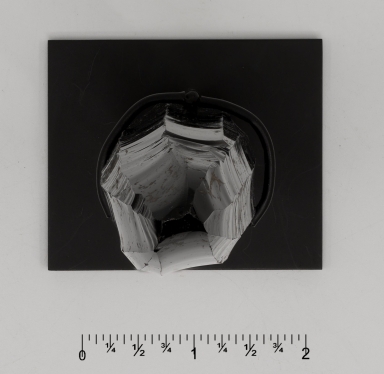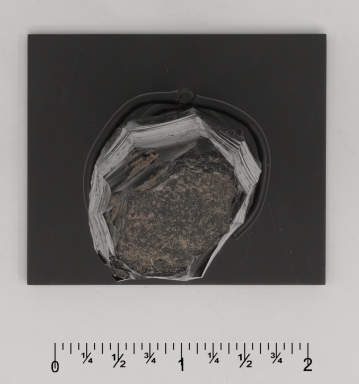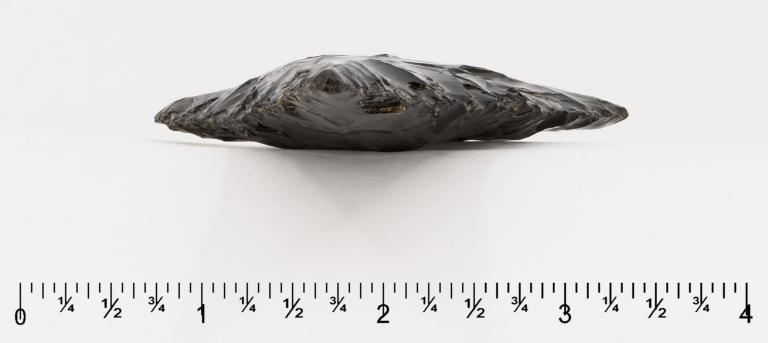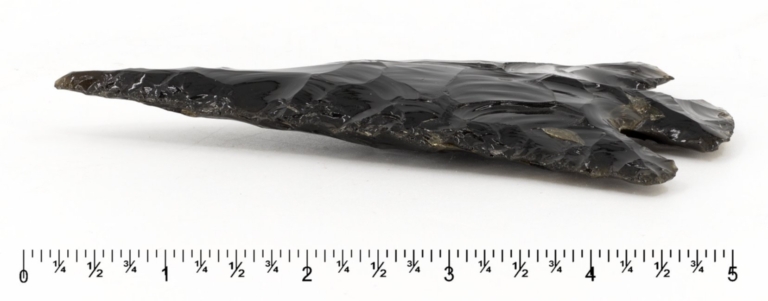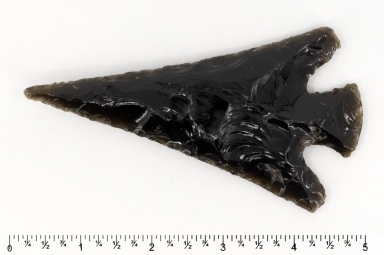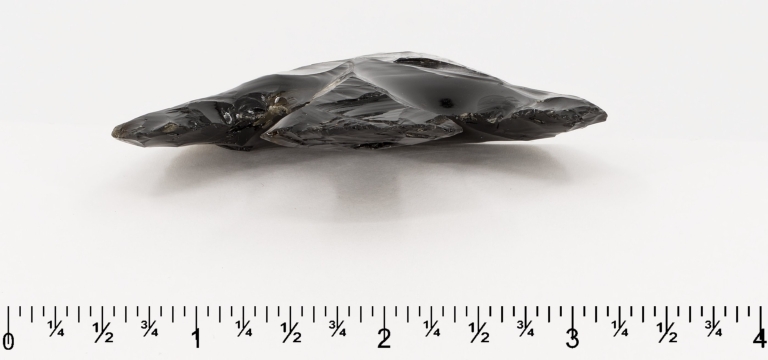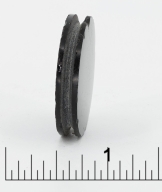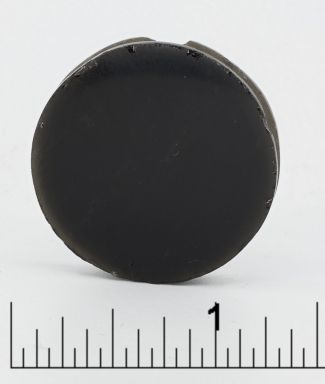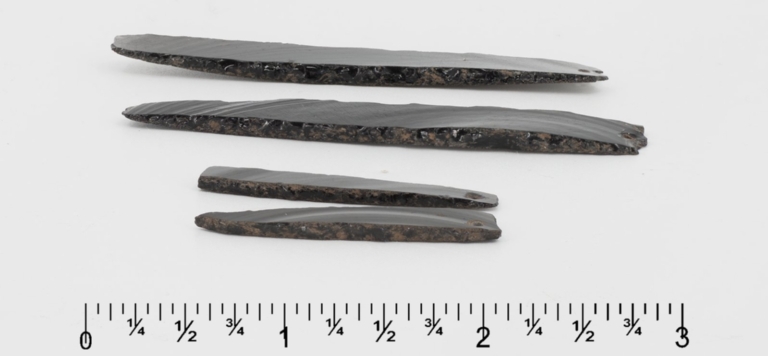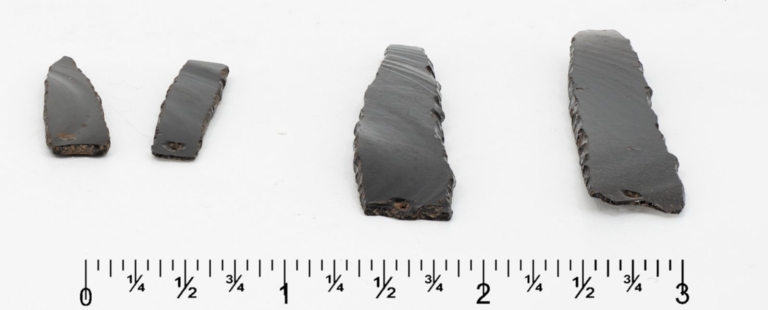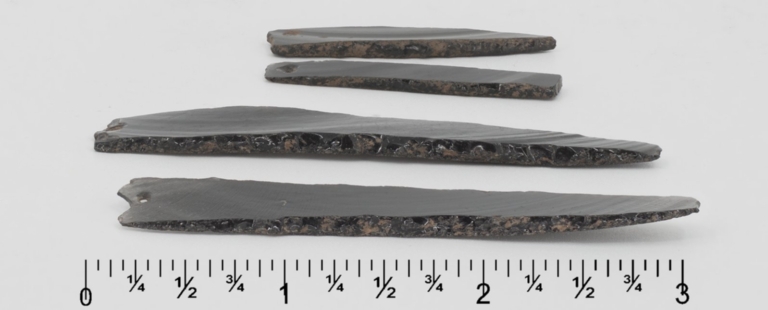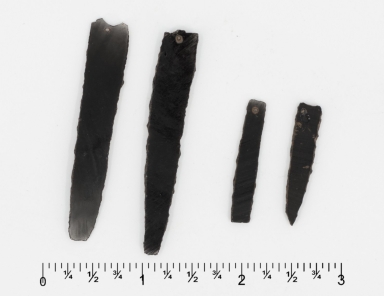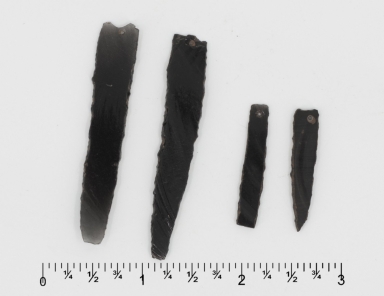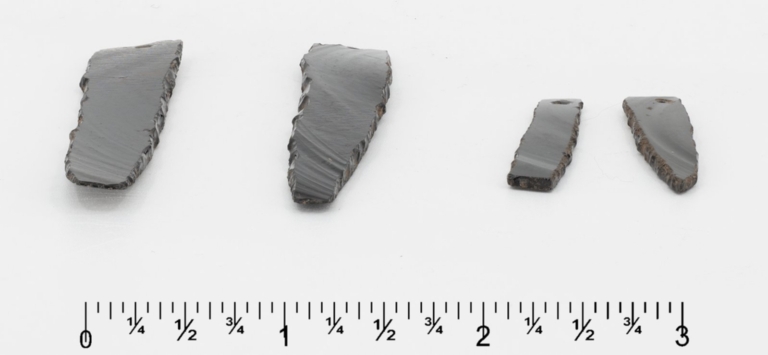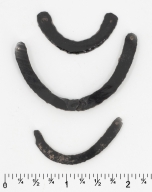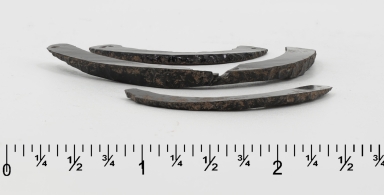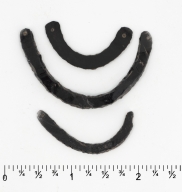|
REFINE
Browse All : Artifact and Obsidian
1-26 of 26
Title
Obsidian core.
Description
Obsidian, the stone of choice for making cutting tools, produced very sharp blades. The striking surfaces of this core has been oxidized. Long uniform blades have been pressure flaked from the core, running the length of the core. One blade did not reach the top of the core and broke prematurely.
Subject
[Stone carving--Mexico, Weapons--Mexico, Obsidian, Indigenous peoples--Antiquities]
Date
between 250 and 900
Title
Obsidian core.
Description
Obsidian, the stone of choice for making cutting tools, produced very sharp blades. The striking surfaces of this core has been oxidized. Long uniform blades have been pressure flaked from the core, running the length of the core. One blade did not reach the top of the core and broke prematurely.
Subject
[Stone carving--Mexico, Weapons--Mexico, Obsidian, Indigenous peoples--Antiquities]
Date
between 250 and 900
Title
Obsidian core.
Description
Obsidian, the stone of choice for making cutting tools, produced very sharp blades. The striking surfaces of this core has been oxidized. Long uniform blades have been pressure flaked from the core, running the length of the core. One blade did not reach the top of the core and broke prematurely.
Subject
[Stone carving--Mexico, Weapons--Mexico, Obsidian, Indigenous peoples--Antiquities]
Date
between 250 and 900
Title
Obsidian core.
Description
Obsidian, the stone of choice for making cutting tools, produced very sharp blades. The striking surfaces of this core has been oxidized. Long uniform blades have been pressure flaked from the core, running the length of the core. One blade did not reach the top of the core and broke prematurely.
Subject
[Stone carving--Mexico, Weapons--Mexico, Obsidian, Indigenous peoples--Antiquities]
Date
between 250 and 900
Title
Obsidian core.
Description
Obsidian, the stone of choice for making cutting tools, produced very sharp blades. The striking surfaces of this core has been oxidized. Long uniform blades have been pressure flaked from the core, running the length of the core. One blade did not reach the top of the core and broke prematurely.
Subject
[Stone carving--Mexico, Weapons--Mexico, Obsidian, Indigenous peoples--Antiquities]
Date
between 250 and 900
Title
Obsidian core.
Description
Obsidian, the stone of choice for making cutting tools, produced very sharp blades. The striking surfaces of this core has been oxidized. Long uniform blades have been pressure flaked from the core, running the length of the core. One blade did not reach the top of the core and broke prematurely.
Subject
[Stone carving--Mexico, Weapons--Mexico, Obsidian, Indigenous peoples--Antiquities]
Date
between 250 and 900
Title
Projectile point : green obsidian.
Description
The only source for green obsidian is located at Pachuca in the modern Mexican state of Hidalgo near Teotihuacan. The point was formed by core flaking and refined with pressure flaking. The Pachuca source was controlled by the Teotihuacanos during the Classic period and later by the Toltecas and Aztecas during the Post Classic period.
Subject
[Stone carving--Mexico--Hidalgo (State), Obsidian, Indigenous peoples--Antiquities]
Date
between 250 and 1521
Title
Projectile point : green obsidian.
Description
The only source for green obsidian is located at Pachuca in the modern Mexican state of Hidalgo near Teotihuacan. The point was formed by core flaking and refined with pressure flaking. The Pachuca source was controlled by the Teotihuacanos during the Classic period and later by the Toltecas and Aztecas during the Post Classic period.
Subject
[Stone carving--Mexico--Hidalgo (State), Obsidian, Indigenous peoples--Antiquities]
Date
between 250 and 1521
Title
Projectile point : green obsidian.
Description
The only source for green obsidian is located at Pachuca in the modern Mexican state of Hidalgo near Teotihuacan. The point was formed by core flaking and refined with pressure flaking. The Pachuca source was controlled by the Teotihuacanos during the Classic period and later by the Toltecas and Aztecas during the Post Classic period.
Subject
[Stone carving--Mexico--Hidalgo (State), Obsidian, Indigenous peoples--Antiquities]
Date
between 250 and 1521
Title
Projectile point : green obsidian.
Description
The only source for green obsidian is located at Pachuca in the modern Mexican state of Hidalgo near Teotihuacan. The point was formed by core flaking and refined with pressure flaking. The Pachuca source was controlled by the Teotihuacanos during the Classic period and later by the Toltecas and Aztecas during the Post Classic period.
Subject
[Stone carving--Mexico--Hidalgo (State), Obsidian, Indigenous peoples--Antiquities]
Date
between 250 and 1521
Title
Projectile point : green obsidian.
Description
The only source for green obsidian is located at Pachuca in the modern Mexican state of Hidalgo near Teotihuacan. The point was formed by core flaking and refined with pressure flaking. The Pachuca source was controlled by the Teotihuacanos during the Classic period and later by the Toltecas and Aztecas during the Post Classic period.
Subject
[Stone carving--Mexico--Hidalgo (State), Obsidian, Indigenous peoples--Antiquities]
Date
between 250 and 1521
Title
Projectile point : green obsidian.
Description
The only source for green obsidian is located at Pachuca in the modern Mexican state of Hidalgo near Teotihuacan. The point was formed by core flaking and refined with pressure flaking. The Pachuca source was controlled by the Teotihuacanos during the Classic period and later by the Toltecas and Aztecas during the Post Classic period.
Subject
[Stone carving--Mexico--Hidalgo (State), Obsidian, Indigenous peoples--Antiquities]
Date
between 250 and 1521
Title
Obsidian disc.
Description
Obsidian has been core flaked and pressure flaked to form a very cylinder. It was abraded and polished the perimeter was grooved wearing.
Subject
[Stone carving--Mexico--Colima (State), Obsidian, Indigenous peoples--Antiquities]
Date
between 1250 and 1521
Title
Obsidian disc.
Description
Obsidian has been core flaked and pressure flaked to form a very cylinder. It was abraded and polished the perimeter was grooved wearing.
Subject
[Stone carving--Mexico--Colima (State), Obsidian, Indigenous peoples--Antiquities]
Date
between 1250 and 1521
Title
Obsidian disc.
Description
Obsidian has been core flaked and pressure flaked to form a very cylinder. It was abraded and polished the perimeter was grooved wearing.
Subject
[Stone carving--Mexico--Colima (State), Obsidian, Indigenous peoples--Antiquities]
Date
between 1250 and 1521
Title
Obsidian disc.
Description
Obsidian has been core flaked and pressure flaked to form a very cylinder. It was abraded and polished the perimeter was grooved wearing.
Subject
[Stone carving--Mexico--Colima (State), Obsidian, Indigenous peoples--Antiquities]
Date
between 1250 and 1521
Title
Obsidian jewelry : earrings.
Description
Once a thin obsidian blade has been knocked off the core, it can be shaped by pressing off tiny pieces of the volcanic stone. The edges can be dulled by rubbing them with different stones. Holes are drilled for suspension. This pair of earrings was crafted this way.
Subject
[Earrings--Mexico--Colima (State), Jewelry--Mexico--Colima (State), Stone carving--Mexico--Colima (State), Indigenous peoples--Antiquities, Obsidian]
Date
between 250 B.C. and 250 A.D.
Title
Obsidian jewelry : earrings.
Description
Once a thin obsidian blade has been knocked off the core, it can be shaped by pressing off tiny pieces of the volcanic stone. The edges can be dulled by rubbing them with different stones. Holes are drilled for suspension. This pair of earrings was crafted this way.
Subject
[Earrings--Mexico--Colima (State), Jewelry--Mexico--Colima (State), Stone carving--Mexico--Colima (State), Indigenous peoples--Antiquities, Obsidian]
Date
between 250 B.C. and 250 A.D.
Title
Obsidian jewelry : earrings.
Description
Once a thin obsidian blade has been knocked off the core, it can be shaped by pressing off tiny pieces of the volcanic stone. The edges can be dulled by rubbing them with different stones. Holes are drilled for suspension. This pair of earrings was crafted this way.
Subject
[Earrings--Mexico--Colima (State), Jewelry--Mexico--Colima (State), Stone carving--Mexico--Colima (State), Indigenous peoples--Antiquities, Obsidian]
Date
between 250 B.C. and 250 A.D.
Title
Obsidian jewelry : earrings.
Description
Once a thin obsidian blade has been knocked off the core, it can be shaped by pressing off tiny pieces of the volcanic stone. The edges can be dulled by rubbing them with different stones. Holes are drilled for suspension. This pair of earrings was crafted this way.
Subject
[Earrings--Mexico--Colima (State), Jewelry--Mexico--Colima (State), Stone carving--Mexico--Colima (State), Indigenous peoples--Antiquities, Obsidian]
Date
between 250 B.C. and 250 A.D.
Title
Obsidian jewelry : earrings.
Description
Once a thin obsidian blade has been knocked off the core, it can be shaped by pressing off tiny pieces of the volcanic stone. The edges can be dulled by rubbing them with different stones. Holes are drilled for suspension. This pair of earrings was crafted this way.
Subject
[Earrings--Mexico--Colima (State), Jewelry--Mexico--Colima (State), Stone carving--Mexico--Colima (State), Indigenous peoples--Antiquities, Obsidian]
Date
between 250 B.C. and 250 A.D.
Title
Obsidian jewelry : earrings.
Description
Once a thin obsidian blade has been knocked off the core, it can be shaped by pressing off tiny pieces of the volcanic stone. The edges can be dulled by rubbing them with different stones. Holes are drilled for suspension. This pair of earrings was crafted this way.
Subject
[Earrings--Mexico--Colima (State), Jewelry--Mexico--Colima (State), Stone carving--Mexico--Colima (State), Indigenous peoples--Antiquities, Obsidian]
Date
between 250 B.C. and 250 A.D.
Title
Obsidian jewelry : crescent-shaped pectorals.
Description
Obsidian is a hard, black volcanic glass that can be worked with ease. Mesoamericans knocked off thin layers or blades from an obsidian core and further refined or shaped their tools or objects by pressing or pushing off small pieces of the stone. Blades were further flattened or worn away with abrasive grits or sands. Holes were drilled or knocked into the blade. These obsidian crescent pendants (jewelry) have been created using the above process.
Subject
[Jewelry--Mexico--Jalisco, Stone carving--Mexico--Jalisco, Art--Mexico--Jalisco, Indigenous peoples--Antiquities, Obsidian]
Date
between 250 B.C. and 250 A.D.
Title
Obsidian jewelry : crescent-shaped pectorals.
Description
Obsidian is a hard, black volcanic glass that can be worked with ease. Mesoamericans knocked off thin layers or blades from an obsidian core and further refined or shaped their tools or objects by pressing or pushing off small pieces of the stone. Blades were further flattened or worn away with abrasive grits or sands. Holes were drilled or knocked into the blade. These obsidian crescent pendants (jewelry) have been created using the above process.
Subject
[Jewelry--Mexico--Jalisco, Stone carving--Mexico--Jalisco, Art--Mexico--Jalisco, Indigenous peoples--Antiquities, Obsidian]
Date
between 250 B.C. and 250 A.D.
Title
Obsidian jewelry : crescent-shaped pectorals.
Description
Obsidian is a hard, black volcanic glass that can be worked with ease. Mesoamericans knocked off thin layers or blades from an obsidian core and further refined or shaped their tools or objects by pressing or pushing off small pieces of the stone. Blades were further flattened or worn away with abrasive grits or sands. Holes were drilled or knocked into the blade. These obsidian crescent pendants (jewelry) have been created using the above process.
Subject
[Jewelry--Mexico--Jalisco, Stone carving--Mexico--Jalisco, Art--Mexico--Jalisco, Indigenous peoples--Antiquities, Obsidian]
Date
between 250 B.C. and 250 A.D.
Title
Obsidian jewelry : crescent-shaped pectorals.
Description
Obsidian is a hard, black volcanic glass that can be worked with ease. Mesoamericans knocked off thin layers or blades from an obsidian core and further refined or shaped their tools or objects by pressing or pushing off small pieces of the stone. Blades were further flattened or worn away with abrasive grits or sands. Holes were drilled or knocked into the blade. These obsidian crescent pendants (jewelry) have been created using the above process.
Subject
[Jewelry--Mexico--Jalisco, Stone carving--Mexico--Jalisco, Art--Mexico--Jalisco, Indigenous peoples--Antiquities, Obsidian]
Date
between 250 B.C. and 250 A.D.
1-26 of 26
|



